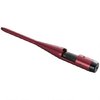Swifty Morgan
member
Generally, I am reluctant to mess with pistol sights. I have had a number of pistols, and it seems like when they're off target, it's usually in the same direction, so I figure it's always me, not the sights. I don't want to adjust the sights so they work with my bad technique. I want to get rid of the bad technique.
That being said, I wonder if anyone has any tips on how to confirm that my sights need to be adjusted. Should I measure the gun's accuracy by resting it and seeing where everything goes, or will that give me a distorted picture of how the gun will work when held in the hands of a shooter with good technique?
I have a new pistol which shoots high and to the right, and in the past, with other guns, I have generally erred to the left and down, so I assume the sights on the new gun should be moved.
That being said, I wonder if anyone has any tips on how to confirm that my sights need to be adjusted. Should I measure the gun's accuracy by resting it and seeing where everything goes, or will that give me a distorted picture of how the gun will work when held in the hands of a shooter with good technique?
I have a new pistol which shoots high and to the right, and in the past, with other guns, I have generally erred to the left and down, so I assume the sights on the new gun should be moved.






